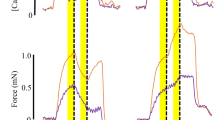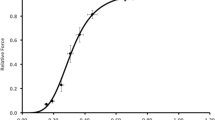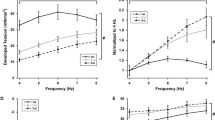Summary
The force produced by muscles declines during prolonged activity and this decline arises largely from processes within the muscle. At a cellular level the reduced force could be caused by: (a) reduced intracellular calcium release during activity; (b) reduced sensitivity of the myofilaments to calcium; or (c) reduced maximal force development. Experiments involving intracellular calcium measurements in isolated single fibres show that all 3 of the above contribute to the decline of force during fatigue. Metabolic changes associated with fatigue are probably involved in each of the 3 factors. Thus the accumulation of phosphate and protons which occur during fatigue cause a reduction in calcium sensitivity and a decline in maximal force. The cause of the reduced intracellular calcium during contractions in fatigue is less clear. During prolonged tetani the conduction of the action potential in the T-tubules appears to fail leading to reduced intracellular calcium in the central part of the muscle fibre. However, during repeated tetani there is a uniform decline of intracellular calcium across the fibre and this remains one of the least understood processes which contribute to fatigue.
Similar content being viewed by others
References
Allen DG, Lee JA, Westerblad H. Intracellular calcium and tension in isolated single muscle fibres from Xenopus. Journal of Physiology (London) 415: 433–458, 1989
Bigland-Ritchie B, Woods JJ. Changes in muscle contractile properties and neural control during human muscular fatigue. Muscle and Nerve 7: 691–699, 1984
Blanchard EM, Solaro RJ. Inhibition of activation and troponin calcium binding of dog cardiac myofibrils by acidic pH. Circulation Research 55: 382–391, 1984
Cooke R, Pate E. The effects of ADP and phosphate on the contraction of muscle fibers. Biophysics Journal 48: 789–798, 1985
Dawson MJ, Gadian DG, Wilkie DR. Muscular fatigue investigated by phosphorus nuclear magnetic resonance. Nature (London) 274: 861–868, 1978
Donaldson SK, Hermansen L. Differential, direct effects of H+ on Ca2+-activated force of skinned fibers from the soleus, cardiac and adductor magnus muscles of rabbits. Pflügers Archiv 413: 422–428, 1978
Eberstein A, Sandow A. Fatigue mechanisms in muscle fibres. In Gutman E & Hnik P (Eds) The effect of use and disuse on neuromuscular functions, pp. 515–526, Amsterdam, Elsevier, 1963
Fabiato A, Fabiato F. Effects of pH on the myofilaments and the sarcoplasmic reticulum of skinned cells from cardiac and skeletal muscles. Journal of Physiology (London) 276: 233–255, 1978
Fleischer S, Inui M. Biochemistry and biophysics of excitation-contraction coupling. Annual Review of Biophysics and Biophysical Chemistry 18: 333–364, 1989
Godt RE, Nosek TM. Changes of intracellular milieu with fatigue or hypoxia depress contraction of skinned rabbit skeletal and cardiac muscle. Journal of Physiology (London) 412: 155–180, 1989
Gonzalez-Serratos H, Somlyo AV, McCellan G, Shuman H, Borrero LM, et al. Composition of vacuoles and sarcoplasmic reticulum in fatigued muscle: electron probe analysis. Proceedings of the National Academy of Science (USA) 75: 1329–1333, 1978
Jones DA, Bigland-Ritchie B, Edwards RHT. Excitation frequency and muscle fatigue: mechanical responses during voluntary and stimulated contractions. Experimental Neurology 64: 401–413, 1979
Juel C. Intracellular pH recovery and lactate efflux in mouse soleus muscles stimulated in vitro: the involvement of sodium/proton exchange and a lactate carrier. Acta Physiologica Scandinavia 132: 363–371, 1988
Lamb GD, Stephenson DG. Effect of Mg2+ on the control of Ca2+ release in skeletal muscle fibres of the toad. Journal of Physiology (London) 434: 507–528, 1991
Lee JA, Westerblad H, Allen DG. Changes in tetanic and resting [Ca2+]i during fatigue and recovery of single muscle fibres from Xenopus laevis. Journal of Physiology (London) 433: 307–326, 1991
Merton PA. Voluntary strength and fatigue. Journal of Physiology (London) 123: 553–564, 1954
Nakajima S, Nakajima Y, Peachey LD. Speed of repolarization and morphology of glycerol-treated from muscle fibres. Journal of Physiology (London) 234: 465–480, 1973
Noma A. ATP-regulated K+ channels in cardiac muscle. Nature (London) 305: 147–148, 1983
Renaud JM, Allard Y, Mainwood, GW. Is the change in intracellular pH during fatigue large enough to be the main cause of fatigue? Canadian Journal of Physiology and Pharmacology 64: 764–767, 1986
Smith JS, Coronado R, Meissner G. Sarcoplasmic reticulum contains adenine nucleotide-activated calcium channels. Nature (London) 316: 446–449, 1985
Spruce AE, Standen NB, Standfield PR. Voltage-dependent ATP-sensitive potassium channels of skeletal muscle membrane. Nature (London) 316: 736–738, 1985
Wendt I, Stephenson DG. Effects of caffeine on Ca-activated force production in skinned cardiac and skeletal muscle fibres of the rat. Plügers Archiv 398: 210–216, 1983
Westerblad H, Allen DG. Changes of myoplasmic calcium concentration during fatigue in single mouse muscle fibers. Journal of General Physiology 98: 1–21, 1991
Westerblad H, Allen DG. Changes in intracellular pH due to repetitive stimulation of single mouse skeletal muscle fibres. Journal of Physiology, in press, 1992
Westerblad H, Lånnergren J. Force and membrane potential during and after fatiguing, inermittent tetanic stimulation of in single Xenopus muscle fibres. Acta Physiologica Scandinavica 128: 369–378, 1986
Westerblad H, Lee JA, Lamb AG, Bolsover SR, Allen DG. Spatial gradients of intracellular calcium in skeletal muscle during fatigue. Pflügers Archiv 415: 734–740, 1990
Westerblad H, Lee JA, Lånnergren J, Allen DG. Cellular mechanisms of fatigue in skeletal muscle. American Journal of Physiology 261: C195–C209, 1991
Author information
Authors and Affiliations
Rights and permissions
About this article
Cite this article
Allen, D.G., Westerblad, H., Lee, J.A. et al. Role of Excitation-Contraction Coupling in Muscle Fatigue. Sports Medicine 13, 116–126 (1992). https://doi.org/10.2165/00007256-199213020-00007
Published:
Issue Date:
DOI: https://doi.org/10.2165/00007256-199213020-00007




